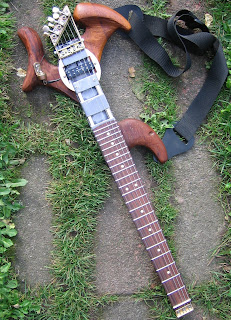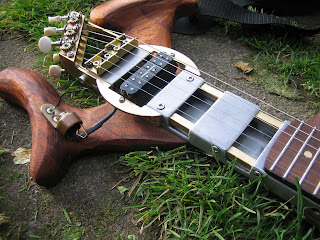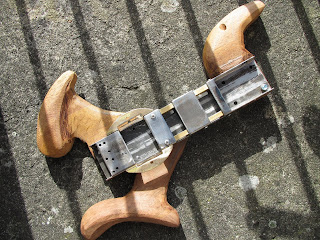What started as a testbed has turned into a nice, playable guitar.
For the first time, I've made a working guitar that I believe suits my position and style better than anything I could buy. This was the problem, that initially, some four years ago, got me interested in ergonomics and the possibility of building your own, very personal guitar.
That's something of a milestone, actually.
[Blogspot insists on rotating the image on the right. I have no idea why, and I can't fix it]
Things I like about the guitar:
It's comfortable to play. There's still much adjustment (and probably replacement of some wooden parts) to do, but it's more comfortable than any other guitar that I've played.
With the Seymour Duncan pickup, it sounds at least decent. My first impression is that it's a bit shrill, probably due to the steel body.
It's modular, meaning that I can replace components when I want without taking the whole guitar apart.
It's easily adjustable, making it possible to try different positions.
It's thin where it matters ...the area of the body around the bridge pickup hole is only 20 mm thick. And that's the place where it matters, because this is the area with which the guitar rests against my chest. This means that I can have it close to my body without having to reach my arms around it.
Everything on it works. Tuning, intonation, action, pickup adjustment, neck bow, etc. Some parts work really well (the bridge and wooden arm and thigh rest), while some could use improvement (the tuners and the strap horn).
The roughness and homemadeness are style elements, which are imposed by my lack of workshop skills (and the fact that I don't much like to spend money on having a professional doing it for me (because if you spend money, you have to work more, and I'm not particularly fond of that, either)). But I've come to like the roughness and the fact that you can see that the parts are made from stock metal. There's a certain honesty to it.
Things I'm doing these days:
- Playing the guitar
- Tuning the guitar (I'm dissatisfied with the tuner system, but it works well enough for now)
- Moving and adjusting the wooden pieces
- Adjusting action and intonation. That's pretty easy on the two part bridge, but I am going to make an improved version with the saddle piece at the rear, and fixing and adjustment screws towards the neck. That'll give more room for the new tuner.
Things I might do next:
- Add some copper tubing for the pickup wires.
- Copper jack cover plus master volume and switch. I plan to use the principle of copper "cups" that Rick Toone made.
- New tuner system (see picture)
- New bridge
- Make a wide copper pickup cover that covers the bridge cavity.
- Shape and smooth the wooden pieces. They're quite rough and lack a common "theme" of shapes and curves.
- Blue the body
- Test my current transformer pickups on the guitar (after all, it's thought out as a testbed)
But first, I have to buy some more tools and some more metal.




